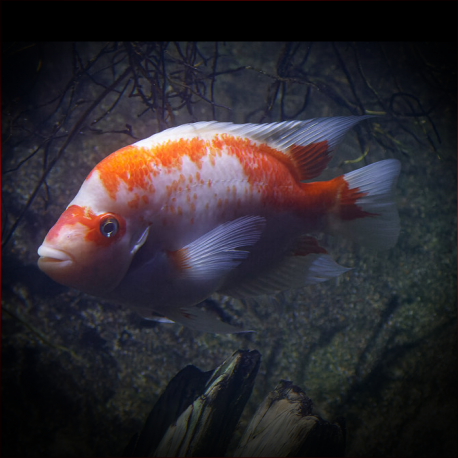More info
Datasheet
| Minimum Tank Size | 300 litres / 79.25 US gallons |
| Maximum Size | 35.0cm / 13.78inches |
| Temperature | 21°C / 69.80°F - 26°C / 78.80°F |
| Hardness | 5.04dgH / 90ppm - 25.04dgH / 447ppm |
| pH | 6.0-8.0 |
General Description
The Red Devil (Amphilophus Labiatus) is a cichlid species previously classified under the genus Cichlasoma. This species, native to Lakes Nicaragua and Managua in Central America, is often mistaken for the Midas Cichlid (A. citrinellus) due to their similar appearance, with notable differences in morphology such as larger lips and nuchal hump size. Selectively bred for color variations, Red Devils are popular among aquarists for their intelligence and distinctive personalities.
Aquarium Setup
Setting up a tank for Red Devils requires robust decor as they are known to rearrange substrate and uproot plants regularly. Avoid live plants and opt for heavy rocks, driftwood, and large flowerpots that are too heavy to be moved. Visual barriers should be provided if housing other fish to mitigate aggression. Protect equipment like heaters and filter inlets from the fish's curiosity and aggression. A large, efficient filter and weekly water changes are essential, along with a secure tank cover to prevent excitable jumping episodes.
Behaviour
Red Devils are notoriously aggressive cichlids, especially towards tankmates, necessitating cautious consideration when housing them. In smaller tanks, their aggression can be a significant issue, and the recommended tank size for managing aggression is over 1000 liters. Keeping multiple males together is not advisable in any tank size, as they are prone to attacking each other and any other tankmates.
Feeding and Diet
Red Devils are opportunistic feeders, readily accepting a varied diet. Offering high-quality cichlid sticks supplemented with live or frozen foods like earthworms, prawns, and mussels is ideal. Vegetables such as peas and spinach should also be included in their diet. Foods high in protein, like beefheart, are not recommended due to potential digestive issues. While they consume smaller fish in the wild, feeding live fish in captivity offers little nutritional benefit.
Reproduction & Dimorphism
Breeding Red Devils requires a compatible pair, with males demonstrating aggressive behavior towards females if not properly introduced. Tank setup for breeding should include potential spawning sites like large rocks and flowerpots. With successful pairing, breeding is usually straightforward, characterized by courtship rituals, egg laying in caves or on rocks, and attentive parental care. Sexual dimorphism is evident in larger males with longer fins and prominent nuchal humps during the breeding season.
Habitat and Distribution
Endemic to Lakes Nicaragua and Managua in Central America, Red Devils are commonly found near submerged rocky areas in these lakes. Lake Managua faces significant pollution challenges, while Lake Nicaragua, the only freshwater lake supporting a shark population, provides a cleaner habitat for these cichlids. Their distribution is limited to these interconnected lakes through the Tipitapa River.

